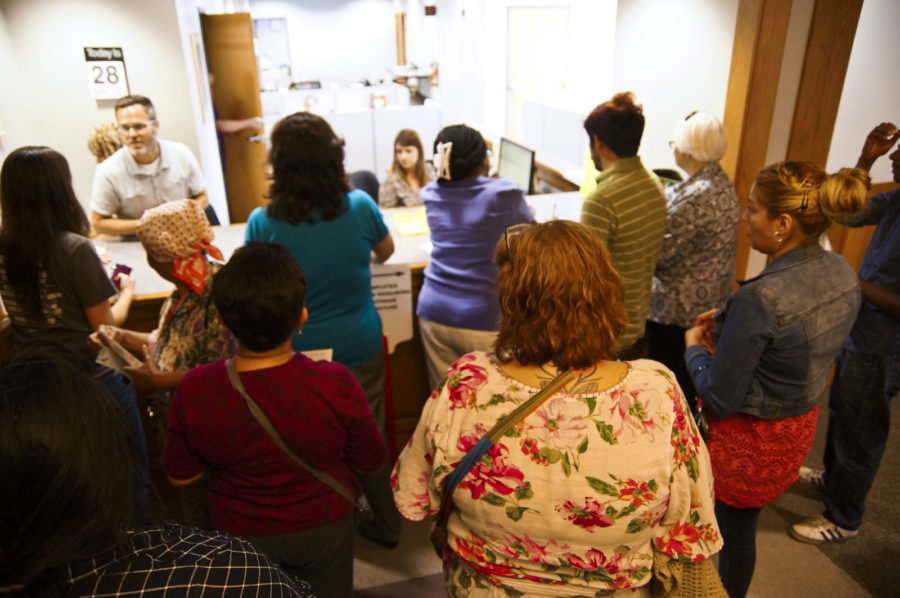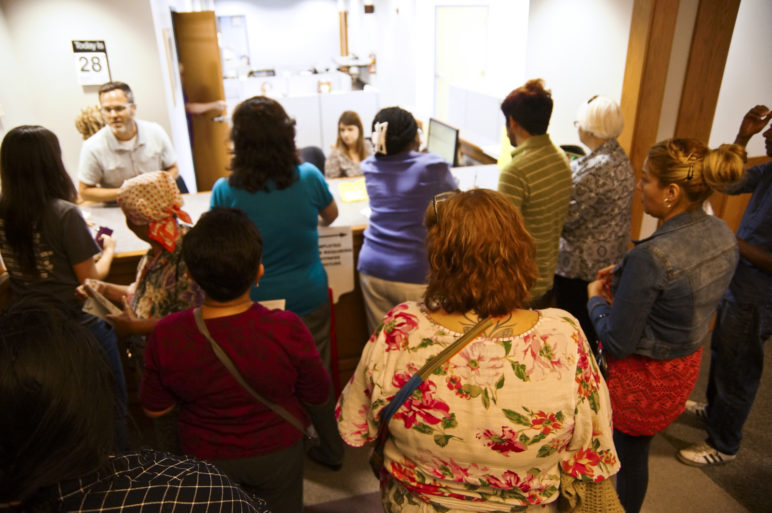When you take the trouble to vote, you want it to matter that you did. You want your vote to make a difference in who gets elected. You want your vote to elect someone you like, so that for the next few years you can know that person is in office, shaping policy on issues that are important to you.
Single-winner districts and the gerrymander sap voters’ power by wasting their votes in two ways: predetermining winners in safe districts and denying many voters the power to elect a representative.
But single-winner districts and the gerrymander sap voters’ power by wasting their votes in two ways: predetermining winners in safe districts and denying many voters the power to elect a representative. If your district is safe for one party or the other, it won’t much matter whether you vote—if you hold the minority view, you’ll never be able to elect a like-minded representative, and if you hold the majority view, your candidate will win in a landslide so it won’t matter if you stay home. About half the votes in safe districts won’t matter. If your district is competitive then it will matter that you turn out to vote, but there is about a 50 percent chance you’ll end up with no one representing your views in the legislature. About half the voters in each competitive district will be unrepresented.
If you are an American or Canadian who has never known anything but this wasteful electoral system, the math might seem inevitable to you. You might be shrugging, thinking: “Some voters vote for the loser. That’s just life.” You might be thinking of elections like a football or hockey game: “One team wins, the other loses. So yeah, half the teams lose, so what? Everyone doesn’t get a trophy!”
Electing a president might be like a football game, with just one winner and lots of disappointed fans of the losing team. But electing a legislature is more like ordering a bunch of pitchers of beer for a group of people watching the football game. Since there are lots of pitchers, almost everyone at the table should be able to drink something they like. If half or more of the people at the table asked for the beer they liked but didn’t get it, they wouldn’t just shrug and say “I voted for the losing beer. That’s just life.” They would demand a say in choosing at least one of the pitchers. Similarly, if there are lots of legislators, every voter should have a say in electing at least one representative they like.
Unfortunately, no amount of tweaking the gerrymander in single-winner districts will ensure that your vote matters and that you can elect someone you like. But multi-member districts let voters choose multiple pitchers of beer, so to speak.
Wasted votes are a mathematical certainty in single-member districts
A powerful vote is one that a candidate needs to get elected and that succeeds in electing that candidate. A wasted vote is one that is unnecessary (surplus) because the candidate would have won anyway, or unsuccessful (lost) because the candidate does not win. To American or Canadian voters this probably sounds like just the way things work—sometimes your candidate wins by a lot and sometimes she doesn’t win, but that doesn’t mean your vote was wasted, it just means that’s how the election turned out. But surplus and lost votes are the gerrymander’s weapons. The heart of the gerrymandering case going before the US Supreme Court is a test that measures how many votes for each party were wasted (surplus or lost).
Intentional partisan gerrymandering uses two strategies to waste the other party’s votes. First, line-drawers can “pack” one party’s voters into safe districts where the winner has a huge surplus beyond what they need to win. Before any candidate has declared his candidacy, long before voters fill in their ballots, the race can already be called just by looking at the district lines. By herding one party’s voters into this one district, line-drawers create many surplus votes for that party and deny those additional voters the ability to elect an additional representative.
Second, the line-drawers can “crack” voters across competitive districts where many of their votes are lost on a losing candidate. In competitive districts nearly half of voters vote for the loser, meaning their vote didn’t have the power to elect a representative. By drawing lines that barely tip the advantage to their own party, line-drawers ensure that the other party wastes close to half the votes in that district.
If a party can draw district after district where the other party is either winning in a landslide (wasting surplus votes) or just barely losing (wasting nearly half its votes), it can circumvent the will of the people, ensuring the line-drawers’ party gets more seats than it has votes. For example, in the gerrymandering case the US Supreme Court will hear this fall, Wisconsin’s Republican-drawn district maps enabled Republicans to win more than 60 percent of seats in the state house despite winning less than 49 percent of the vote.
No, that big Supreme Court gerrymandering case won’t ensure your vote matters
The US Supreme Court has previously declined to strike down partisan gerrymandering because it didn’t have a reliable test for identifying partisan gerrymandering. But it recently agreed to hear a partisan gerrymandering case, signalling that it might be ready to adopt the test the appeals court used. The federal court of appeals used a three-pronged test to determine that the district maps were illegally gerrymandered:
- the district line-drawers intended to disempower voters of one political party,
- the district maps had that effect, and
- the maps could not be justified on other grounds.
To prove the second prong—that the maps disproportionately wasted one party’s votes—the court used the “efficiency gap,” a formula researchers developed for measuring how many votes for each party were wasted.
But even if the court uses the analysis of wasted votes to strike down extreme partisan gerrymandering, no one can change the fact that in every single-winner district, half the votes are surplus or lost. If a redistricting map passes the “efficiency gap” test, it just means that roughly half of both Democratic and Republican votes are wasted.
Other academics have proposed alternative ways for the court to test whether district maps unfairly waste more votes from one party than the other, including geometric compactness scores, computational methods, computer programs, and a mathematical index. All of these tests could improve the fairness between the two major parties, but none can protect you, the voter, and ensure your vote matters. Ironically, as explained in Part 1 of this series, more competitive districts might lead to fewer voters having a like-minded representative. If every district contains about half Democrats and half Republicans, then half the voters won’t have a representative they like. If you are a voter in a competitive district, there is about a 50 percent chance you’ll end up with no one representing your views in the legislature.
With multi-member districts, your vote matters and you can elect a representative you like
Americans and Canadians are so accustomed to anachronistic single-member districts, we might not even realize we should be outraged at our lack of power and lack of representation. We reason that, when electing a president or a governor or a mayor, only one person wins—there’s just one trophy. Mathematically, many opposition voters will inevitably be unhappy with the outcome. And we accept the same level of unhappiness with legislatures.
But legislatures are different. There are many legislators. Many people get a trophy, so to speak. The whole point of electing 435 United States representatives or 98 Washington representatives or 60 Oregon representatives is that there are lots of them and they can represent a diversity of voters. There’s no reason for half or more of voters to settle for no representation in a multi-member body like a legislature.
Most developed democracies figured this out during the twentieth century and adopted electoral methods that gave more voters more power to elect legislators of their choice. Different countries accomplish this in different ways, but they all have one thing in common: they don’t use single-member districts. They let voters have say in electing a group of legislators at once. One way that Americans and Canadians could finally get around to doing this would be to use multi-member districts and let voters rank their choices.
For example, in Washington state, voters already elect three representatives (one state senator and two state representatives) from a district. But they vote for each one separately. Imagine instead you elected them all at once. Same number of options on the ballot, same number of representatives for the district. Instead of seeing six candidates listed two at a time in three different races electing a total of three people, you would see six candidates listed in one race electing a total of three people (sort of like this ballot ). You rank your choices. Say your first-choice candidate, Felicia Fund College, loses. The way we vote now, your vote would effectively be thrown in the trash and you’d tell yourself “I voted for the loser. That’s life.”
With a ranked ballot, your vote would get transferred to your next-ranked candidate still in the running. Say your next choice was Maria Moderate. But she is quite popular and already has 10 percent more votes than she needs to win a seat. Instead of those extra votes being surplus (wasted), all of Maria’s voters have 90 percent of their vote contribute to her win, and 10 percent of their vote transferred to their next-ranked candidate who is still in the running. Everyone’s entire vote has the chance to elect candidates they like; none of it is wasted. Every voter gets exactly one vote, but every vote counts towards electing one or more of the three representatives.
Don’t settle
Americans and Canadians are so used to wasting our votes in legislative elections, we have come to think of it as inevitable. But wasted votes, and gerrymandering the lines to waste more of some people’s votes than others, are only inevitable if we choose to use single-member districts. Multi-member districts deal a death blow to the gerrymander by making most votes matter.











Greg Cusack
My only comment, Kristin, is that IF these candidates arrive on the general ballot as a result of partisan primaries, then the voters will still be likely left with one or more candidates that represent more extreme positions than most voters would wish. If present patterns hold (and, given our increasingly divisive, unthinking, tribal divide, there is no reason to think they would suddenly change), then the majority party’s candidate will still likely come in first, even in multi-member districts.
While such districts will almost certainly prompt more moderate alternative candidates to step forward, knowing that they would have a reasonable chance to be elected as perhaps the second preferred candidate, they would also have to mount expensive campaigns to overcome the advantage enjoyed by major party candidates.
IF, however, multi-member elections were applied to PRIMARY elections, then the resulting candidate(s) would be much more likely to be more moderate persons, enhancing the over all value of the subsequent general election.
Or, perhaps even better, if primaries were just eliminated, then a larger variety of persons would be likely to present themselves as candidates.
Any thoughts on this?
Kristin Eberhard
Eliminate primaries! Primaries are the modern day poll tax, allowing a small, unrepresentative group of voters to pick the candidates for the rest of us. Ranked ballots plus some reasonable barrier to entry to keep vanity candidates from cluttering up the ballot would allow the more numerous, more diverse, general election voters to have more say in who represents them.
Alternatively, keep primaries, but let everyone participate and rank their choices. For example, in a 3-member district, the open primary could use a ranked ballot and advance the top 7 candidates, so general election voters should have a good variety of options and pick the most representative 3.
Sorry, I now realize the role of primaries in multi-member districts is not clear here. But I am planning to write more about the unrepresentative effects of low-turnout primaries. (Especially Oregon’s closed primaries, which completely silence a large and growing number of voters who prefer not to register with one of the major parties)
Kelly Gerling
Thanks for the first two articles on multi-member districts. They are and important aspect of proportional representation voting. I have a question about how we implement this idea for choosing members of our national House of Representatives. A 1967 law called the Uniform Congressional District Act forbids such districts.
It states:
“2 U.S. Code § 2c – Number of Congressional Districts; number of Representatives from each District
US Code
In each State entitled in the Ninety-first Congress or in any subsequent Congress thereafter to more than one Representative under an apportionment made pursuant to the provisions of section 2a(a) of this title, there shall be established by law a number of districts equal to the number of Representatives to which such State is so entitled, and Representatives shall be elected only from districts so established, no district to elect more than one Representative (except that a State which is entitled to more than one Representative and which has in all previous elections elected its Representatives at Large may elect its Representatives at Large to the Ninety-first Congress).”
https://www.law.cornell.edu/uscode/text/2/2c
Given the fact that the law exists, and that the two major parties would not have a motive to repeal the law to give citizens the right through multimember districts to choose other parties that can take power, what would motivate members of Congress to repeal the law? Secondly, with strategies can we as citizens do to overcome this problem?
Ed Duhaime
If I understand this system correctly, it is kind of a hybrid between proportional voting and winner-take-all, or a limited proportional voting system.
While we are dreaming of a better electoral system, how about the possibility of instead of rank choice voting (instant runoff with multiple winners) maybe use majority judgement voting. Majority judgement voting is where every candidate gets to be ‘graded’ (excellent, good, neutral, poor, bad) and the most ‘liked’ wins. (BTW If we had Majority Judgement voting in the presidential primary we would have had John Kasich against Bernie Sanders in the general election).
Majority Judgment voting with multiple member representation who get to vote in the legislature proportional to their ‘grade’ would overcome several problems. It would overcome gerrymandering, give proportional representation AND a proportional (fractional according to their ‘grade’) vote in the legislature.
The main weakness of Majority Judgment where there is only one winner would be overcome: people, rather than being honest, would be tempted to list all other candidates except the one they like as ‘bad’ to try to sway the overall grading. With multiple winners this possibility would be diminished with multiple winners.
For more about Majority Judgement voting see Majority Judgment – Wikipedia
Sara Wolf
Interesting! I’ll check that out. Majority judgement sounds a lot like Star Voting, which I’m working on. Have you looked into that? It’s like you describe (you give 5 star rankings to each candidate) but then there’s an instant runoff where the top two candidates are finalists. Your ballot already shows which finalist you preferred and the finalist preferred by more voters wins. There’s also a PR/multi-winner version.
http://www.equal.vote
Sara Wolf
Good question!